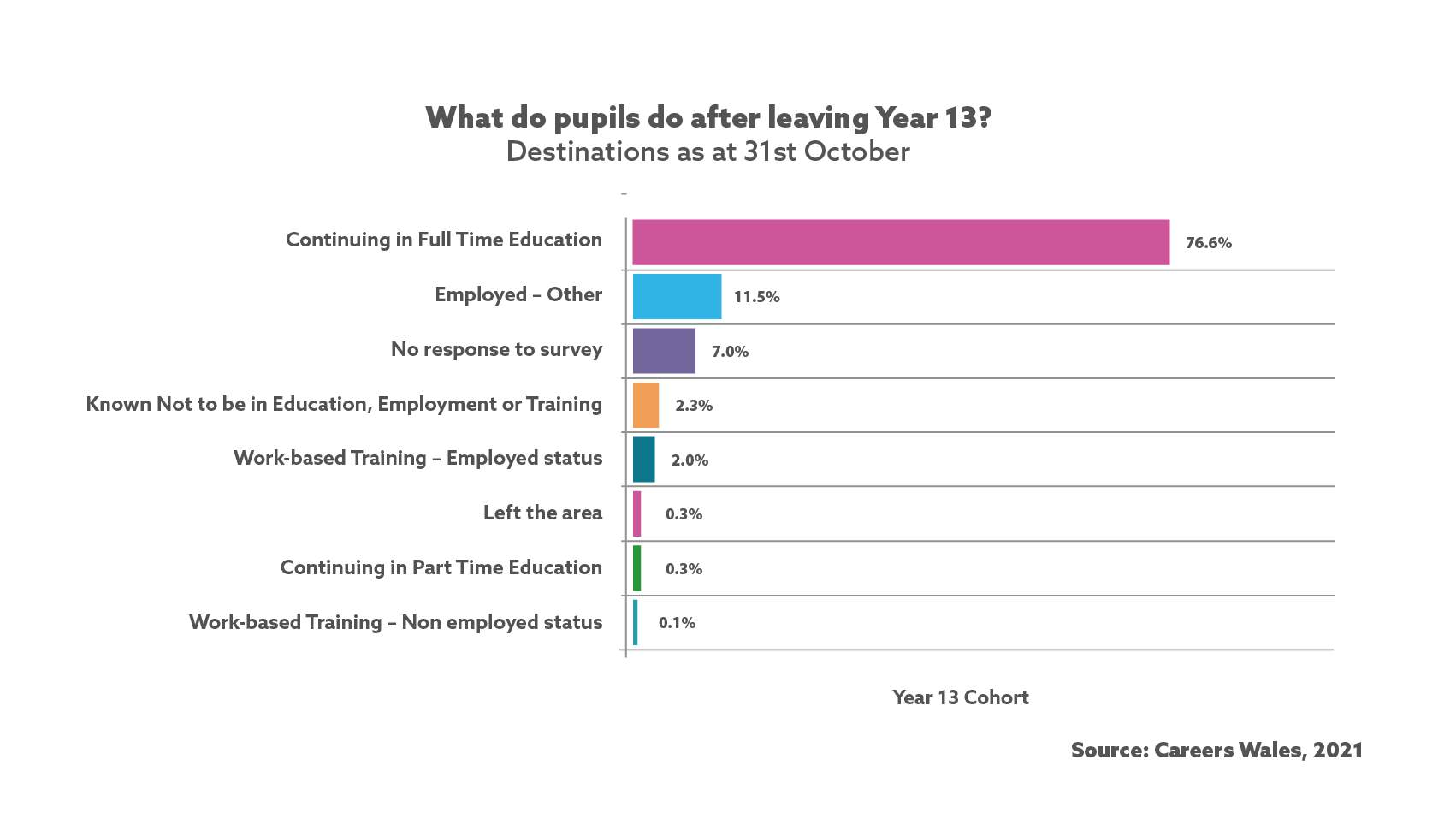Summary
Figures are for students aged 17 or 18 typically in the second year of a school sixth form. The survey, providing the destination of these pupils on the 31st of October 2021 was in respect of 10,937 pupils completing Year 13 in 2021 that is, the 2021 Year 13 destinations cohort.
- 46.3% were male and 53.6% were female
- 79.0% of the cohort (8,639 individuals) went into some form of continued learning in education or work-based training. A higher proportion of the total female cohort were in this category (81.4%) compared to males at 76.1%
- 76.6% of the cohort (8,382 individuals) continued in full time education (FTE). Of those 84.3 % (7,063 individuals) progressed directly to higher education. This represented 64.6% of the total cohort
- 69.2% of the total female cohort progressed directly to higher education and 59.2% of the total male cohort
- Of those continuing within full time education a lower percentage 5.7% (481 individuals) continued their education in school compared to 8.1% (678 individuals) who continued at a further education college. The percentage of the male cohort continuing in FTE, who continued their education in either school or college was higher than that for females (17.3 % and 11.0% respectively)
- The percentage of Year 13 leavers continuing in FTE, who remained in Year 14 in school, stood at 5.7%. The percentage of males stood at 7.7% in 2021 compared to 4.2% of females
- 1.9% (160 individuals) of those continuing in education stated that they were taking a gap year with the intention of going on to higher education the following year
- Continuing in part time education (16 hours or less per week) was the route taken by 34 individuals (0.3%)
- 13.5% (1,477 individuals) entered the labour market, either going into employment or work-based training. 11.5% (1,254 individuals) entered employment outside of Government supported training. 2.9 percentage point more males than females took this route
- A small proportion of the cohort 0.1% (9 individuals) entered work-based training without employed status
- 2.0% (214 individuals) entered work-based learning with employed status. A higher percentage of males (2.6%) than females (1.4%) took this route
- On the survey date, 2.3% (251 individuals) of the cohort were known not to be in any form of education, training, or employment (NEET). A higher percentage of males 2.9% (149 individuals) than females 1.7% (102 individuals) were in this category
- 0.3% (29 individuals) of the cohort were shown to have left their local area
Year 13 Overall Figures
| Status | Male | % | Female | % | Other | % | Total | % |
|---|---|---|---|---|---|---|---|---|
| Continuing in Full Time Education | 3,706 | 73.1 | 4,673 | 79.7 | 3 | 100.0 | 8,382 | 76.6 |
| Continuing in Part Time Education (less than 16 hours a week) | 15 | 0.3 | 19 | 0.3 | 0 | 0.0 | 34 | 0.3 |
| Work Based Training - Non employed status | 5 | 0.1 | 4 | 0.1 | 0 | 0.0 | 9 | 0.1 |
| Work Based Training - Employed status | 133 | 2.6 | 81 | 1.4 | 0 | 0.0 | 214 | 2.0 |
| Employed - Other | 659 | 13.0 | 595 | 10.1 | 0 | 0.0 | 1,254 | 11.5 |
| Known Not To Be In Education, Employment or Training | 149 | 2.9 | 102 | 1.7 | 0 | 0.0 | 251 | 2.3 |
| No response to survey | 388 | 7.7 | 376 | 6.4 | 0 | 0.0 | 764 | 7.0 |
| Left the area | 14 | 0.3 | 15 | 0.3 | 0 | 0.0 | 29 | 0.3 |
| Total number in cohort | 5,069 | 100 | 5,865 | 100 | 3 | 100 | 10,937 | 100 |
Full Time Education (FTE)
| Gender | Percentage of students who stayed in Full Time Education |
|---|---|
| Male | 73.1% |
| Female | 79.7% |
| Status | Male | % | Female | % | Other | % | Total | % |
|---|---|---|---|---|---|---|---|---|
| Continuing to Year 14 in School of 11-18 schools | 284 | 7.7 | 196 | 4.2 | 1 | 33.3 | 481 | 5.7 |
| Year 13 school leavers continuing to colleges of Further Education | 358 | 9.7 | 320 | 6.8 | 0 | 0.0 | 678 | 8.1 |
| Year 13 continuing in Higher Education | 3,000 | 80.9 | 4,061 | 86.9 | 2 | 66.7 | 7,063 | 84.3 |
| Year 13 taking gap year with intention of going to Higher Education | 64 | 1.7 | 96 | 2.1 | 0 | 0.0 | 160 | 1.9 |
| Total | 3,706 | 100 | 4673 | 100 | 3 | 100 | 8,382 | 100 |
Known Not To Be In Education, Employment or Training (NEET)
| Status | Male | % | Female | % | Other | % | Total | % |
|---|---|---|---|---|---|---|---|---|
| Able to enter Employment, Education or WBTYP | 83 | 55.7 | 50 | 49.0 | 0 | 0 | 133 | 53.0 |
| Unable to enter Employment, Education or WBTYP due to illness, pregnancy and other reasons | 66 | 44.3 | 52 | 51.0 | 0 | 0 | 118 | 47.0 |
| Total | 149 | 100 | 102 | 100 | 0 | 0 | 251 | 100 |
Ethnicity
Of those returning information on ethnicity:
- The most popular choice of route across all minority ethnic groups was continuing in full time education at 80.8%. This compared to 76.2% for individuals from a white background
- A higher percentage of those with white backgrounds (7 percentage points difference) entered employment outside of Government sponsored training (12.2% of those from a white background compared to 5.2% of those from a minority ethnic background)
- There was a difference of 1.5 percentage points between white background and ethnic minority groups entering work-based training–employed status (2.1% and 0.6% respectively)
- The proportion of young people from a minority ethnic background who were NEET was lower than that for those with a white background (1.9% compared to 2.3%). This represents 229 individuals from a white background and 19 individuals from a minority ethnic background
| Status | White | % | Minority Ethnic Groups | % | No information on ethnicity | % | Total | % |
|---|---|---|---|---|---|---|---|---|
| Continuing in FT Education (schools and colleges) | 7,476 | 76.2 | 811 | 80.8 | 95 | 81.2 | 8,382 | 76.6 |
| Continuing in Part Time Education (less than 16 hours a week) | 30 | 0.3 | 3 | 0.3 | 1 | 0.9 | 34 | 0.3 |
| WBTYP (without employed status) | 8 | 0.1 | 1 | 0.1 | 0 | 0.0 | 9 | 0.1 |
| WBTYP (employed status) | 205 | 2.1 | 6 | 0.6 | 3 | 2.6 | 214 | 2.0 |
| Employment | 1,196 | 12.2 | 52 | 5.2 | 6 | 5.1 | 1,254 | 11.5 |
| Known Not To Be In Education, Employment or Training | 229 | 2.3 | 19 | 1.9 | 3 | 2.6 | 251 | 2.3 |
| Unknown | 645 | 6.6 | 110 | 11.0 | 9 | 7.7 | 764 | 7.0 |
| Statutory School leavers who are known to have left the area | 27 | 0.3 | 2 | 0.2 | 0 | 0.0 | 29 | 0.3 |
| Total Number in Cohort | 9,816 | 100 | 1,004 | 100 | 117 | 100 | 10,937 | 100 |
| % of Total Cohort | 89.8 | 9.2 | 1.1 | 100 |
View other year groups

View the overall figures of Year 11 pupil destinations from schools in Wales 2021.

View the overall figures of Year 12 pupil destinations from schools in Wales 2021.


